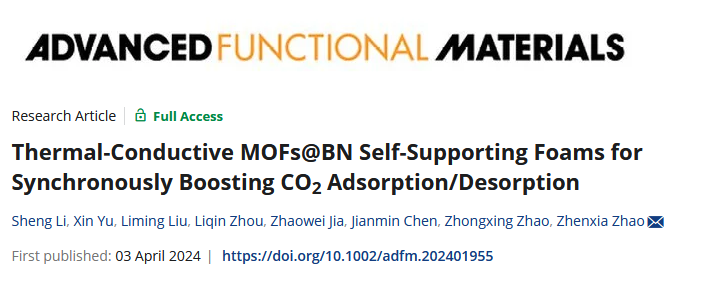Recently, the team of Zhao Zhen Xia in our Institute made a breakthrough in the construction of efficient thermal desorption MOFs foam and its simultaneous enhancement of CO2 absorption and desorption performance. The relevant research results are presented as "Thermal-Conductive MOFs@BN Self-Supporting Foams for Synchronously Boosting CO2. Adsorption/Desorption "was published in Advanced Functional Materials, a top international journal in the field of materials. The first author of this paper is Li Sheng, a doctoral student of our college, and the corresponding author is Professor Zhao Zhenxia of our college.

At present, the combination of MOFs with thermal conductive and foam materials can improve the adsorption/desorption efficiency, but the introduction of low specific surface area guest materials may weaken the adsorption characteristics of MOFs, and the interface thermal resistance also limits the improvement of thermal desorption efficiency. How to construct MOFs composites with high thermal desorption efficiency and enhance CO2 absorption/desorption performance simultaneously is still a challenge for MOFs in the field of CO2 capture.
To address this challenge, Zhenxia Zhao's team proposed a "self-supporting foam" strategy applicable to typical MOFs such as HKUST-1, MIL-100(Fe), and ZIF-8. BNNS and MOFs crystals support each other as "steel bar" and "sand and stone" respectively, and use PEI as "cement" for bonding crosslinking, and successfully prepare thermal conductive MOFs foam with stable self-supporting structure. This self-supporting foam strategy not only solves the problem that the traditional MOFs foam relies heavily on polymer materials, which leads to the loss of the original adsorption performance of MOFs, but also forms a continuous thermal conductivity network between MOFs and BNNS, which enhances the CO2 absorption/desorption performance simultaneously.
The research was supported by the National Natural Science Foundation of China and the Natural Science Foundation of Guangxi.